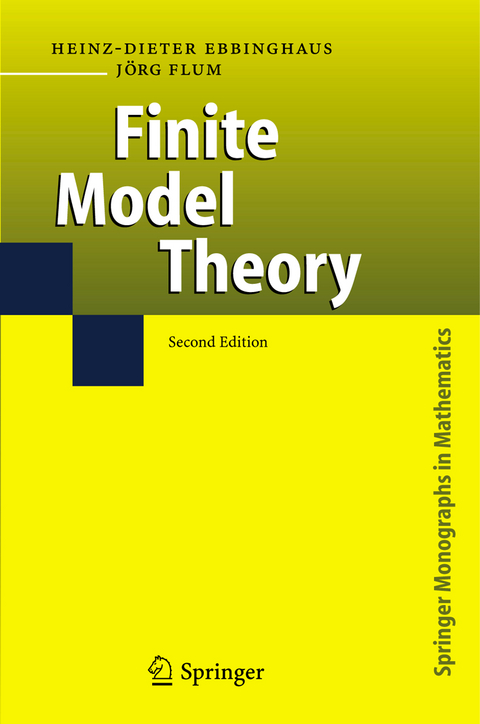
Finite Model Theory
Second Edition
Seiten
2005
|
2. Second Edition 1995
Springer Berlin (Verlag)
978-3-540-28787-2 (ISBN)
Springer Berlin (Verlag)
978-3-540-28787-2 (ISBN)
Finite model theory has roots in classical model theory, but owes its systematic development to research from complexity theory and database theory. The book presents the main results of descriptive complexity theory, that is, the connections between axiomatizability of classes of finite structures and their complexity with respect to time and space bounds. The logics that are important in this context include fixed-point logics, transitive closure logics, and also certain infinitary languages; their model theory is studied in full detail. Other topics include DATALOG languages, quantifiers and oracles, 0-1 laws, optimization and approximation problems.
Finite model theory, the model theory of finite structures, has roots in clas sical model theory; however, its systematic development was strongly influ enced by research and questions of complexity theory and of database theory. Model theory or the theory of models, as it was first named by Tarski in 1954, may be considered as the part of the semantics of formalized languages that is concerned with the interplay between the syntactic structure of an axiom system on the one hand and (algebraic, settheoretic, . . . ) properties of its models on the other hand. As it turned out, first-order language (we mostly speak of first-order logic) became the most prominent language in this respect, the reason being that it obeys some fundamental principles such as the compactness theorem and the completeness theorem. These principles are valuable modeltheoretic tools and, at the same time, reflect the expressive weakness of first-order logic. This weakness is the breeding ground for the freedomwhich modeltheoretic methods rest upon. By compactness, any first-order axiom system either has only finite models of limited cardinality or has infinite models. The first case is trivial because finitely many finite structures can explicitly be described by a first-order sentence. As model theory usually considers all models of an axiom system, modeltheorists were thus led to the second case, that is, to infinite structures. In fact, classical model theory of first-order logic and its generalizations to stronger languages live in the realm of the infinite.
Finite model theory, the model theory of finite structures, has roots in clas sical model theory; however, its systematic development was strongly influ enced by research and questions of complexity theory and of database theory. Model theory or the theory of models, as it was first named by Tarski in 1954, may be considered as the part of the semantics of formalized languages that is concerned with the interplay between the syntactic structure of an axiom system on the one hand and (algebraic, settheoretic, . . . ) properties of its models on the other hand. As it turned out, first-order language (we mostly speak of first-order logic) became the most prominent language in this respect, the reason being that it obeys some fundamental principles such as the compactness theorem and the completeness theorem. These principles are valuable modeltheoretic tools and, at the same time, reflect the expressive weakness of first-order logic. This weakness is the breeding ground for the freedomwhich modeltheoretic methods rest upon. By compactness, any first-order axiom system either has only finite models of limited cardinality or has infinite models. The first case is trivial because finitely many finite structures can explicitly be described by a first-order sentence. As model theory usually considers all models of an axiom system, modeltheorists were thus led to the second case, that is, to infinite structures. In fact, classical model theory of first-order logic and its generalizations to stronger languages live in the realm of the infinite.
Prof. Dr. H.-D. Ebbinghaus ist Leiter des Instituts für Mathematische Logik an der Universität Freiburg. Durch Veröffentlichungen hat der Autor einen hohen Bekanntheitsgrad in der Hochschulmathematik.
Preliminaries.- The Ehrenfeucht-Fraïssé Method.- More on Games.- 0-1 Laws.- Satisfiability in the Finite.- Finite Automata and Logic: A Microcosm of Finite Model Theory.- Descriptive Complexity Theory.- Logics with Fixed-Point Operators.- Logic Programs.- Optimization Problems.- Logics for PTIME.- Quantifiers and Logical Reductions.
| Erscheint lt. Verlag | 6.10.2005 |
|---|---|
| Reihe/Serie | Springer Monographs in Mathematics |
| Zusatzinfo | XI, 360 p. |
| Verlagsort | Berlin |
| Sprache | englisch |
| Maße | 155 x 235 mm |
| Gewicht | 664 g |
| Themenwelt | Mathematik / Informatik ► Informatik ► Theorie / Studium |
| Mathematik / Informatik ► Mathematik ► Allgemeines / Lexika | |
| Mathematik / Informatik ► Mathematik ► Logik / Mengenlehre | |
| Schlagworte | 0-1-laws • Complexity • Complexity theory • descriptive complexity theory • Finite model theory • fixed-point logics • Modelltheorie • model Theory |
| ISBN-10 | 3-540-28787-6 / 3540287876 |
| ISBN-13 | 978-3-540-28787-2 / 9783540287872 |
| Zustand | Neuware |
| Informationen gemäß Produktsicherheitsverordnung (GPSR) | |
| Haben Sie eine Frage zum Produkt? |
Mehr entdecken
aus dem Bereich
aus dem Bereich
was jeder über Informatik wissen sollte
Buch | Softcover (2024)
Springer Vieweg (Verlag)
CHF 53,15
Grundlagen – Anwendungen – Perspektiven
Buch | Softcover (2022)
Springer Vieweg (Verlag)
CHF 53,15
Teil 2 der gestreckten Abschlussprüfung Fachinformatiker/-in …
Buch | Softcover (2025)
Europa-Lehrmittel (Verlag)
CHF 37,90


